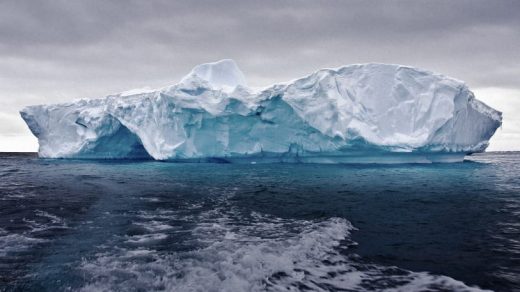One Man’s Ambitious, Insane Plan To Use An Iceberg To Bring Water To The Middle East
In the United Arab Emirates, where the population more than tripled between 2000 and 2015, groundwater could run out in less than 15 years. Desalination plants, which strip salt from seawater, might be the solution in the future, but today they’re both expensive and energy-intensive. One Abu Dhabi company hopes to bring the country water from another source: melting icebergs.
“An iceberg can hold 20 billion gallons of water, which is enough for a million people’s drinking water for five years,” Abdulla Alshehi, founder of National Advisor Bureau Limited, the Masdar-based company pursuing a plan to haul icebergs to the Middle East from Antarctica, tells Fast Company. (Because icebergs are made from snow, they contain freshwater and not saltwater.) “So it’s a huge quantity we’re talking about. Unfortunately, due to what’s happening from global warming, many icebergs are disintegrating in Antarctica. Once they disintegrate, they float in the ocean and they melt, wasting billions of gallons of the water resources of the Earth.”
Within months, a Delaware-sized chunk of ice may split from an ice shelf in Antarctica, where a crack has grown to 110 miles long. Though that particular chunk of ice is already floating in the water and won’t cause sea level rise, it holds back land-based glaciers that will push sea levels higher when they melt. The idea of using icebergs as a water source–equal parts visionary and crazy–isn’t new, but the push is more urgent now because of climate change. Alshehi sees the project as a way to mitigate sea level rise while making use of the purest water in the world. He suggests–perhaps equally fantastically–that the melting iceberg could also help offset the briny water that desalination plants dump along the coast, and that the presence of the iceberg could help cool the area.

Along with drinking water, he hopes to use the water to begin to irrigate part of the Empty Quarter or Rub’ al Khali, the largest sand desert in the world, which was covered in grasslands and woodlands when early humans first lived there. “The ambition is to fill it with greenery as it used to be thousands of years ago,” Alshehi says. “The iceberg will be one source of water to reach that goal.” The project, which Alshehi detailed in a book called Filling the Empty Quarter: Declaring a Green Jihad on the Desert, would begin with a “great green wall” of vegetation along the desert’s edge. (In another, even more improbable part of the proposal, he suggests building an 300-mile-long undersea pipe to connect the UAE with freshwater from Pakistan, where frequent flooding is a problem and the massive Dasht River dumps freshwater into the Arabian Sea.)
Alshehi is not the first to consider hauling icebergs to places that need drinking water. As early as the mid-1800s, small icebergs were towed from Antarctica to Chile for use in breweries, and another entrepreneur suggested towing icebergs to India. By the mid-1900s, oceanographer John Isaacs proposed iceberg towing as a less energy-intensive alternative to desalination. In the 1970s, researchers from the RAND Corporation analyzed how it could work, envisioning a train of icebergs wrapped in plastic to keep them from melting (they also proposed using a floating nuclear power station to feed power to propellers on each iceberg). In 1977, a Saudi Arabian prince funded an international conference to explore the idea. More recently, French engineer Georges Mougin revived the idea–but trials that were supposed to begin in 2012 or 2013 have yet to occur.
To date, no one has succeeded. But towing does happen regularly on a smaller scale. When 100,000-ton icebergs drift toward offshore oil platforms in Canada, the industry tows them away. “If you ask someone from C-Core, they’ll tell you that they’re iceberg cowboys,” says Aleksey Marchenko, a professor in ice mechanics at the University Center in Svalbard, an Arctic university, referring to a Candian research and development company that moves icebergs both for the fossil fuel industry and for companies like Iceberg Vodka.
Those icebergs are towed using a combination of nets, synthetic line, and steel wire connected to ships. “I’m not sure this same technology could be applied to larger icebergs,” Marchenko says. It’s not clear what size iceberg Alshehi plans to transport, but Marchenko says that “There’s no sense in towing a small iceberg for freshwater.” The oil and gas industry also only tows icebergs relatively short distances.
One challenge is determining the best route to take. Currents and wind can change direction, making it difficult to move an unwieldy and massive chunk of ice.
If a ship guides an iceberg relatively quickly–half a meter per second–it would take a month to cover 1,000 kilometers (currents and storms could slow it down). The trip from Antartica to the coast of Fujairah, over 10,000 kilometers, could take a year or more. Along the way, the iceberg risks melting or breaking, while the ships that tow it operate at huge expense.
Alshehi is still in the process of finding investors for the trip, which he hopes to begin in 2018. If the project moves forward, the company would choose an iceberg using satellite images, wrap it in insulating material to lessen melting, and tie it up and connect it with ships and barges. Once the iceberg is 25 kilometers offshore of the UAE, the company plans to crush the ice, fill up floating tankers, and bring it to land.
Though the process hasn’t happened before, Alshehi is optimistic. “We will be the first, inshallah,” he says.
(52)



